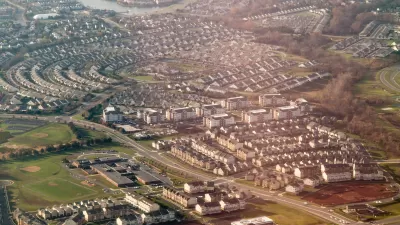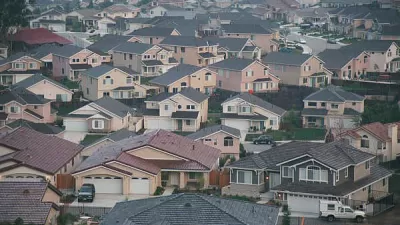In this opinion piece from The Huffington Post, Alex Becker argues that retrofitting suburban landscapes with denser development trumps all other sustainability agendas as the single most important path to a more sustainable future.
Becker highlights suburban areas as a prime starting point in the movement towards more sustainable, resilient cities in the United States. He states that the answer to how we should best utilize our existing suburban infrastructure is "simple," and that planners and policymakers should aim first and foremost to "Move things closer together!"
Becker continues:
"Calls to be greener and use less energy are all well and good, but ultimately mean nothing unless we can fundamentally restructure the suburban environment in which a large swath of the American public lives. In suburbia, overconsumption may seem like a choice (and perhaps at a certain extreme level it is), but the physical reality remains that large-scale resource consumption is the only way to survive in the environment which we've built for ourselves. 50% of Americans live in suburban spaces only inhabitable with a large dollop of natural resources."
FULL STORY: Life After Sprawl: Why the Green Revolution Must Start in Suburbia

Study: Maui’s Plan to Convert Vacation Rentals to Long-Term Housing Could Cause Nearly $1 Billion Economic Loss
The plan would reduce visitor accommodation by 25,% resulting in 1,900 jobs lost.

Alabama: Trump Terminates Settlements for Black Communities Harmed By Raw Sewage
Trump deemed the landmark civil rights agreement “illegal DEI and environmental justice policy.”

Why Should We Subsidize Public Transportation?
Many public transit agencies face financial stress due to rising costs, declining fare revenue, and declining subsidies. Transit advocates must provide a strong business case for increasing public transit funding.

Paris Bike Boom Leads to Steep Drop in Air Pollution
The French city’s air quality has improved dramatically in the past 20 years, coinciding with a growth in cycling.

Why Housing Costs More to Build in California Than in Texas
Hard costs like labor and materials combined with ‘soft’ costs such as permitting make building in the San Francisco Bay Area almost three times as costly as in Texas cities.

San Diego County Sees a Rise in Urban Coyotes
San Diego County experiences a rise in urban coyotes, as sightings become prevalent throughout its urban neighbourhoods and surrounding areas.
Urban Design for Planners 1: Software Tools
This six-course series explores essential urban design concepts using open source software and equips planners with the tools they need to participate fully in the urban design process.
Planning for Universal Design
Learn the tools for implementing Universal Design in planning regulations.
Smith Gee Studio
Alamo Area Metropolitan Planning Organization
City of Santa Clarita
Institute for Housing and Urban Development Studies (IHS)
City of Grandview
Harvard GSD Executive Education
Toledo-Lucas County Plan Commissions
Salt Lake City
NYU Wagner Graduate School of Public Service




























